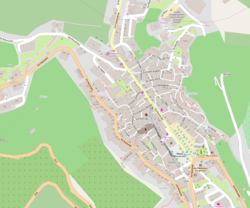
Stilo is a town and comune in the province of Reggio Calabria, in the Calabria region of southern Italy. It is 151 kilometres (94 mi) from Reggio.

Felitto is a town and comune in the province of Salerno in the Campania region of south-west Italy. It is famous for fusilli, a kind of handmade pasta, and the annual Fusillo festival.
Serramazzoni is a comune (municipality) in the Province of Modena in the Italian region Emilia-Romagna, located about 45 kilometres (28 mi) west of Bologna and about 30 kilometres (19 mi) southwest of Modena.
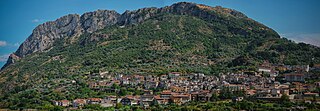
Bivongi is a comune (municipality) in the Province of Reggio Calabria in the Italian region Calabria, located about 50 kilometres (31 mi) southwest of Catanzaro and about 80 kilometres (50 mi) northeast of Reggio Calabria in the Stilaro Valley, at the feet of the Monte Consolino.
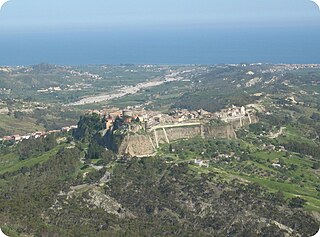
Caulonia is a comune (municipality) in the Province of Reggio Calabria in the Italian region Calabria, located about 60 kilometres (37 mi) southwest of Catanzaro and about 120 kilometres (75 mi) northeast of Reggio Calabria in the Stilaro Valley. Originally it was known as Castelvetere, but in 1862 the citizens decided to change the name of the town to that of the ancient city Caulonia. They believed that this city had been located on their territory, but it was eventually proved that ancient Caulonia was to be found near modern Monasterace, 16 kilometres (10 mi) to the northeast.

Monasterace is a comune (municipality) in the Province of Reggio Calabria in the Italian region Calabria, located about 50 kilometres (31 mi) south of Catanzaro and about 90 kilometres (56 mi) northeast of Reggio Calabria. The ruins of the ancient Greek city Caulonia are located a short distance north of the frazione Monasterace Marina, on the coast. Also north of Monasterace Marina is the Monasterace Archeological Museum, where finds from Caulonia are exhibited.

Placanica is a comune in the Province of Reggio Calabria in the Italian region Calabria, located about 60 kilometres (37 mi) south of Catanzaro and about 80 kilometres (50 mi) northeast of Reggio Calabria. Placanica borders the following communes: Caulonia, Pazzano, Stignano.

Riace is a comune (municipality) in the Metropolitan City of Reggio Calabria in the Italian region Calabria, located about 50 kilometres (31 mi) south of Catanzaro and about 80 kilometres (50 mi) northeast of Reggio Calabria. Riace borders the municipalities of Camini and Stignano.

Mongiana is a comune (municipality) in the Province of Vibo Valentia in the Italian region Calabria, located about 50 kilometres (31 mi) southwest of Catanzaro and about 25 kilometres (16 mi) southeast of Vibo Valentia.
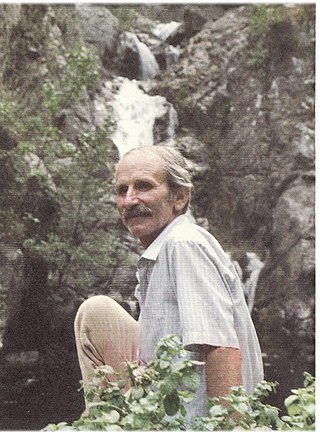
Giuseppe Coniglio, known as U poeta,, was an Italian poet who wrote in Pazzanese, a variety of the Calabrian dialect (language).

The Vallata dello Stilaro is a valley in the Province of Reggio Calabria of Southern Italy. It takes its name from river that flow in the area, the Stilaro.

The Ecomuseo delle ferriere e fonderie di Calabria is an ecomuseum in Bivongi, Calabria, southern Italy.
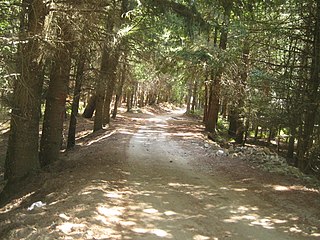
Ferdinandea is an area of 3600 hectare in Serre Calabresi included in the territories of Bivongi, Stilo, Brognaturo, Mongiana and Serra San Bruno in the provinces of Reggio Calabria and Vibo Valentia.

Monte Consolino is a mountain in the Serre Calabresi range, in the Vallata dello Stilaro of south-western Calabria, in southern Italy. Monte Consolino has an altitude of 701 metres (2,300 ft).

Monte Stella is a mountain in the Serre Calabresi, in the Locride, Calabria, southern Italy. It is part of the Vallata dello Stilaro, in the comune of Pazzano.
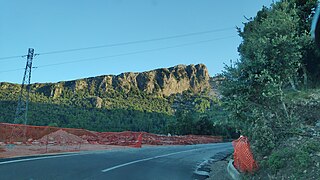
Monte Mammicomito is a massif in the Serre Calabresi, southern Calabria, southern Italy. It is composed of Devonian-origin limestone.
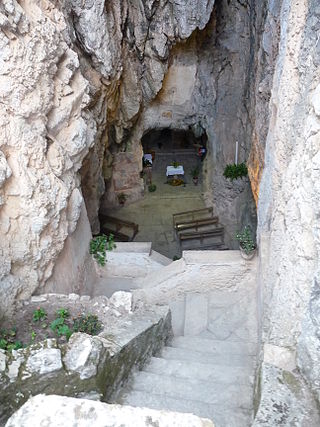
Hermit of Santa Maria della Stella or Sanctuary of Santa Maria della Stella is an Italian hermitage, sited in a natural cave at Pazzano (Calabria) on Monte Stella in Calabria, Italy.

The Natural Regional Park of Serre is a protected natural area of Calabria, Italy created in 2004.

Reali ferriere ed Officine di Mongiana or Villaggio Siderurgico di Mongiana was an iron and steel foundry in the small town of Mongiana, in Calabria (Italy). It was founded in 1770–71 by the Bourbons of Naples and closed in 1881, 20 years after the Kingdom of Italy was established. In 1860 the foundry employed up to 1600 workers.

